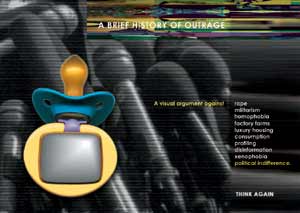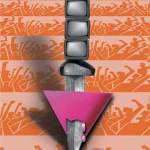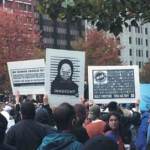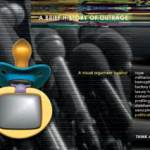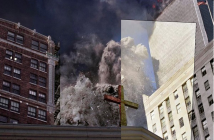A brief history of outrage? How brief? Can we talk about the ridiculous number of parking tickets I get in Kenmore Square, or the car-swallowing potholes every ten feet? What about the T’s plan to run the Green Line out Centre Street again in JP? Or the loss of most of the alternative spaces for art in Boston?
How about Condi Rice, George W, no jobs, higher taxes, war, crime, gay-bashing constitutional amendments and the CIA dictating our television shows? Now we’re getting somewhere.
In their new book, A BRIEF HISTORY OF OUTRAGE, agit-artists THINK AGAIN have collected their favorite works from the past decade, showcasing their in-the-moment, on-the-streets brand of protest art and social movement. The book itself feels a lot like a well-designed scrapbook, actually, loaded with snapshots of billboards, postcard racks and street protests that are joined together in a slick, and often overwhelming, design scheme. The result, though, seems to be what THINK AGAIN intended: this book is not only a history of their work and their outrage, but a how-to guide as well. Slick graphics about homophobic television or U.S. imperialism inspire outrage, but to see them out in the street, on the side of trucks and towering over the streets on billboards gives the real context of political art, and shows that action is just as important as style when it comes to motivating the masses.
One of the most amazing aspects of THINK AGAIN, and thus their book, is that their collaboration spans the country. Founders S.A. Bachman and David Attyah are based in Boston and Los Angeles respectively, although for the last two years Bachman has temporarily relocated to LA for the creation of this book. Below is an interview via email, about A BRIEF HISTORY OF OUTRAGE and the work of THINK AGAIN.
BRS: How did the two of you start collaborating together, and when did you become THINK AGAIN?
THINK AGAIN: We began making work together in the mid 90’s – during the Clinton years – where the tenor of national and international politics were different than today, and queers were facing a different cultural circumstance. Then, the national focus was on the constriction of immigrant rights, the widening wealth gap, the destruction of affirmative action, and the revoking of welfare and other social programs. For lesbians and gays, there was the troubling move to mainstreaming the gay movement, which largely translated to the seeking of sponsorship of large corporations. We were together one night around S.A’s kitchen table and she looked up and said "you know, I don’t think I can bear another Gay Pride parade where the focus is on whether or not we can get the attention of AT&T." National gay political organizations were focused on getting acknowledgment of queers in public rather than today’s emphasis on marriage and domestic life. We produced a set of postcards together, entitled "Queer Essentials," and took them to Pride and started talking to people on the street about progressive queer politics and coalition politics.
These are the two things that have remained constant for us: graphic intervention and direct action.
BRS: Can you talk about the projects you have done in Boston?
There are many, but there are two that typify the way THINK AGAIN thinks and works. On World AIDS Day in 1997, we decided to talk back to the mainstream press, which had decided that World AIDS Day didn’t require frontpage coverage. Certainly, progressives had questions at the time about whether AIDS has quietly been removed from what the cultural was willing to talk and think about. Our solution was simple, we designed our own headline: "THE AIDS CRISIS IS NOT OVER," and plastered it across almost every Boston Globe in every newspaper box on Mass Ave. The project typifies one of our priorities: to think about how the media structures our sense of what qualifies as political and attention worthy. The piece, of course, was also a nod to Gran Fury’s famous piece of the same name.
In 1999, we also completed a collaborative Boston-based project with United for A Fair Economy, a nonprofit organization whose mission is to raise awareness about income and wealth inequity. It was a great project for us, because we were able to work collaboratively and independently. For UFE, we designed a series of billboards asking who benefits from Clinton’s "economic boom." The billboards foregrounded the reality that wages were falling while wealth for the richest grew exponentially. We asked: "Economic Boom for Whom?" The billboards appeared along commuter routes in Mattapan, Somerville, and Jamaica Plain – all places where largely upper middle class commuters had to pass through working class neighborhoods in order to get to their jobs.
Of course, UFE needed billboards that reflected the message of their organization, but THINK AGAIN was interested in pushing the criticism to a more biting assault on gentrification. Independently, we designed a companion wheatpaste poster entitled "White Blight" that essentially called out the beneficiaries of economic prosperity, asking how "community revitalization" masks the real phenomenon of gentrification. Theses posters went up at ground level in Boston and San Francisco, mainly on construction housing for luxury loft construction. Of course, in that year, luxury housing construction boomed by almost 40% in both cities, while affordable housing construction dropped. The title, of course, is a reference to "White Flight" – the major exodus of upper middle class white families from American central cities in the 1970’s. In 2001, Strategic Actions for a Just Economy, based in Los Angeles, used the poster for a public action protesting the building of an entertainment district to "recover" the Figueroa Corridor. Facing displacement, working poor renters held placards proclaiming "We are not blight." to the L.A. planning committee.
BRS: The book, A Brief History of Outrage, seems to be a sort of how-to guide for agit-artists. Do you feel that THINK AGAIN is starting to focus on the future, and inspiring new artists to become active?
When we speak about our work, there is always a naysayer in the audience who says: "Aren’t you just preaching to the converted?" The presumption is that artmaking can’t really change anyone’s mind, and that essentially agitprop only serves people who are already on board with the message. To that, of course, we retort: what’s wrong with preaching to the converted? Certainly all we hear from liberal commentator is that the Right is effective precisely because it continually cultivates support from it’s base.
Part of our mission has always been cheerleading – and in certain cases challenging – the people in the trenches doing the hard work of grassroots social change. We love it when our postcards and posters wind up over someone’s desk or on the refrigerator at home. We also receive incredible feedback and engage in amazing conversations with all sorts of progressive people.
Certainly, artists have also been inspired by the work – especially the fact that every graphic piece gets distributed by direct action and face-to-face contact. Aesthetically and conceptually, our images hold a lot of interest especially for photographers, digital and media artists, and people engaged in a critique of visual culture. Much of what inspires artists also comes from questions of cash: you did that with only $200 a month? Our message to the art community is that you don’t need a $150,000 foundation grant to get people’s attention.
BRS: So many of the pieces in the book refer to specific moments in pop culture (TV Shows, for example). How do you straddle the line between being "in-the-moment" and yet making work that also holds up over time?
What’s optimistic about your question is the suggestion that the culture’s visual and political milieu transforms rapidly, if at all. We’ve certainly had many projects that have continued for years. Protestgraphics.org (2001) was a series of downloadable click-and-print posters to protest the invasion of Afghanistan and to try to challenge the Bush Administrations move to militarism after the events after 911. Nearly three years later, much of that work has been used in international protests against invasion in Iraq. The strategy of that work is not to address the specific case of Afghanistan per se, but to challenge the discursive terms that legitimize acts of invasion – "infinite war," preemptive strike, empire and superpower privilege.
Addressing the cultural logic of the media – rather than specific pieces of media itself – has been fruitful for much of our work. For example, our project entitled CIATV.net, launched in 2001, questioned the increasingly blurry lines between news reporting and entertainment, as all the major networks premiered new dramatic shows sympathetic to the CIA (in the same fiscal year Bush looks to increase Pentagon funding). "Bigger budgets, higher ratings, and now a spot on primetime," was our tag, that eerily prefigured the debate over embedded journalism a year later, and currently "made for TV" information programs produced by the federal government intended to influence political sentiment. Certainly, the Pentagon now has a line item for "image enhancement" that appears on network television.
On the question of permanence, also, is that THINK AGAIN deliberately works in the artistic tradition of political imagemaking. Much of our work makes explicit reference to artists like Gran Fury, Barbara Kruger and Sue Coe, in an attempt to align our work to art historical movements that view the image as inherently political. In 2000, we were involved in the historical retrospective of political art entitled Antagonisms at the Contemporary Museum of Art in Barcelona. The curator there remarked that our work continues a tradition of using the graphic poster as a mode of critique, although unlike other print artists, our work privileges analysis over sloganeering. That’s the polite way of saying "THINK AGAIN is not afraid to use a lot of text on a really small postcard."
BRS: The Marriage Discriminates project is quite interesting. Can you talk about its origins, and how you came to use trucks as traveling billboards?
Popping the Question launched in February of 2000 and questioned the role of the state in sanctioning marriage. At base, we were interested in marital status as a form of discrimination – against queers, against single people, against other groups like the elderly and working poor – and questioned whether gay marriage really served the purposes of a progressive queer agenda. The mobile billboard campaign circulated through Boston and San Francisco (including a stop in front of City Hall on Valentines’ Day - the day of the year when the most marriage ceremonies are performed.).
At the time we launched Popping the Question, the issue of gay marriage wasn’t really on the national agenda. A bit ahead of the wave, our project is still important and timely, as Bush cronies designate 1.5 billion dollars to encourage heterosexual marriage and introduce federal initiatives to link welfare to marital status. Now we’ve got Bush’s willful confusing of the legal institution of marriage and moral institution of marriage.
Popping the Question is typical of THINK AGAIN’s approach. We wanted to link the personal terms of marriage – people’s individual sense of what they want for themselves like security and human connection – to the most global and structural terms – for example, the multi-billion dollar wedding industrial complex or the elaborate legal privileges afforded to people based on their romantic choices. The project is pretty deliberately designed to try to move people up and down those levels of experience, from the personal to the political and back again.
Ultimately, for queers we asked: "The question isn’t whether the state should marry queers, the question is whether the state should marry anyone."
The project went mobile because of the changing structure of public space – we literally couldn’t buy traditional billboard space because the booming economy sent ad prices through the roof. It was also a moment when large media companies had bought most of the public ad space in San Francisco and Boston, and essentially refused to sell space to anyone who wanted to use it for purposes other than selling commodities. The days of pro-bono space for artists has rapidly ended. Our solution: we rented some trucks and then hand-bound inkjet billboards to them. The crisis that moved us toward "mobile" ended up being a boon because it brought our artwork to street level and moved our message through local neighborhoods. Now, we work almost exclusively in the mobile form.
BRS: The cover of the book shows a pacifier nipple with a TV screen attached. How did you come up with this image? Is it an icon for THINK AGAIN's view of America?
There’s an important distinction to be made between what many artists involved media criticism do, and what THINK AGAIN tries to accomplish. Although a substantial portion of our work interrogates the mainstream media – not just fictional television and advertising, but also news and information reporting of all kinds – we are mostly interested in how the media influences and undermines political participation. In that regard, THINK AGAIN doesn’t necessarily argue that too much of the culture is dominated by media or advertising (though it does drive us nuts). We interested in something more specific: how political consciousness can’t exist without interrogating politics AND interrogating mediated images of politics.
Regarding "a view of America," we wouldn’t conceputalize the problem that way, certainly since we are interested talking to a number of different audiences: from queers, to people of color, to immigrants, to television producers, to grassroots activists, to old school feminists, to people living and working for change outside of the United States – who in our experience don’t necessarily share the same relationship to television and the media. In this regard, television per se is not a monolithic thing, nor do people have a monolithic relationship to it.
BRS: Your outrage seems to come accompanied by action. How does anger transition into artwork?
Certainly outrage is a central trope in THINK AGAIN’s efforts, both because of its sense of political determination, but also because of the long history of out/rage in queer organizing and action.
The outrage, however, is also combined with a good deal of sociological analysis, hard evidence and culture theory. THINK AGAIN works hard to deliver people a piece of analysis or a way of looking at a problem that, combined with outrage, makes for political art that has an intellectual and emotional life. For example, our recent piece entitled Hello/Hola attempted both to memorialize the women of Juarez, Mexico (brutally sexually assaulted and murdered), while also revealing the structural forces of misogyny, global capital, and state corruption that put poor migrant women in sexual and economic jeopardy. Just as present for us as outrage is sadness, nostalgia, utopian hopefulness and a sense of pride in belonging to a political and artistic tradition of using the image as a form of political critique.
BRS: Your book contains a scan from Newsweek of you holding a protest sign. The text of the piece below is less than flattering, and seems to hold you up as all that is wrong in America. Do you feel that you are taking back your cause from Newsweek by printing this page in your book?
We certainly were the illustration for everything wrong with liberal America – of course we were in good company, as Edward Said, Cornell West, and Susan Sontag were among the accused. The image appears in our book along with the arrest citation we received for putting up anti-war posters on Hollywood Boulevard a few days before the Oscars in 2003. Both are there to draw attention to the forms of expression and speech that are apparently villianized in this new moment when patriotism, and the demonstration of loyalty to an "American" international project, are of fashion. Certainly – as activists and as artists – we are concerned by the attack on dissent (see Bitter Pill, oppositeNewsweek). We’re not sure whether Newsweek is to blame for attacking dissent, or more likely, the attack on dissent is now newsworthy, warranting editorial space. It holds a contradiction: if Bush fancies the US as the caretaker of international democracy, he presumably needs a healthy relationship to permitting democratic populations to dissent. But that of course generates a certain number of public relations problems for a superpower mired in the Gulf.
So far you've attacked gentrification, homophopic television, CIA influence in the media, the discrimination of marriage, U.S. imperialism, queer-specific marketing, and rights for immigrants. What's next on the THINK AGAIN schedule?
On the dock for 2004 is a project called "Priority List," which is targeted to the queer community and encourages people to participate in the devising of a progressive political agenda for queers, not necessarily governed by the national debate on gay marriage. One of our concerns is the gay marriage debate tends to focus national gay politics on questions of middle and upper-middle class domesticity, and in a different way, disappears queers from public life and enforces traditional models of sex and family. Gay marriage tends to benefit queers who think assimilation is a key component of social change, and have achieved the economic and social stability necessary to form traditional families. This leaves out every single kid in every high school in the US who is trying to avoid getting the crap beaten out of them at school while their teachers look on.
The argument, of course, is that mainstream recognition– even if it is via gay marriage and appeals to the mores of mainstream heterosexual middle-class culture - leads to the most political change. We disagree. One of our concerns is that gay marriage will de-politicize the range of things queer people are interested in organizing for. Do we really believe that once gay people that have achieved a certain level of marital security and status in this society that they’re going to go to bat for fair labor practices or a living wage?
THINK AGAIN wonders what is left out of the debate: universal health care, anti-harrassment efforts in the workplace, condom distribution, queer-affirmative school curriculums, queer-affirmative immigration policies, revisionist sex education (that does not privilege abstinence and marriage) and alternative housing for nontraditional families and caregivers. Our next project attempts to make a Priority List that is inclusive of the economic, racial and generational diversity of the queer community.
- A THINK AGAIN postcard, reading ‘Target Marketing is not a social movement’
- THINK AGAIN’s protest graphics in action.
- The cover of A BRIEF HISTORY OF OUTRAGE.
Links:
THINK AGAIN's AGITART.ORG
THINK AGAIN's PROTESTGRAPHICS.ORG
THINK AGAIN's CIATV.NET
A BRIEF HISTORY OF OUTRAGE is available now.
All images are courtesy of the artists.
Matthew Nash is the publisher of Big RED & Shiny.

